Menus
- How was that yesterday?
- The performance of the Kawasaki W 800 wasn’t captivating
- Technical data Kawasaki W 800
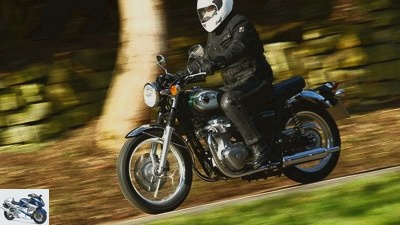
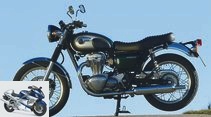
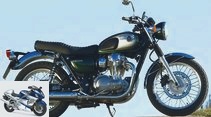
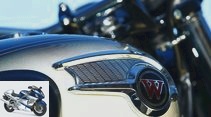
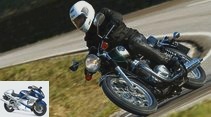
16 photos
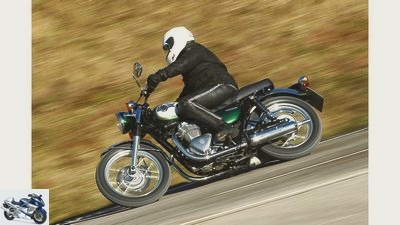
1/16
Kawasaki W 800.
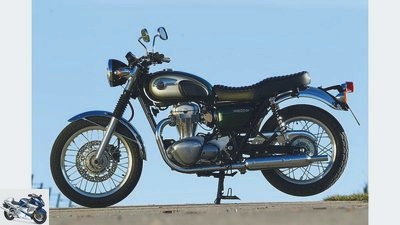
2/16
Kawasaki W 800.
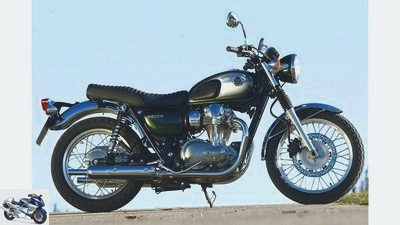
3/16
Kawasaki W 800.
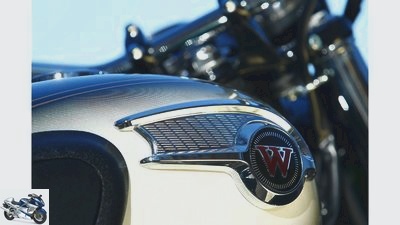
4/16
Kawasaki W 800.
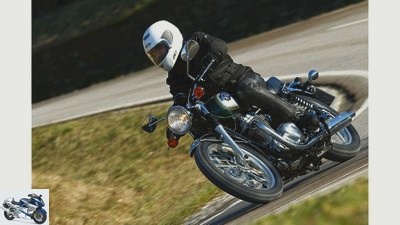
5/16
Kawasaki W 800.
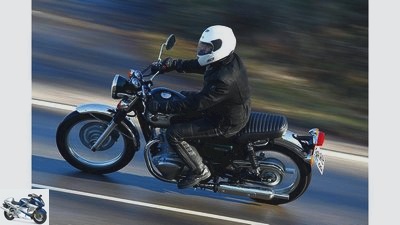
6/16
Kawasaki W 800.

7/16
Kawasaki W 800.
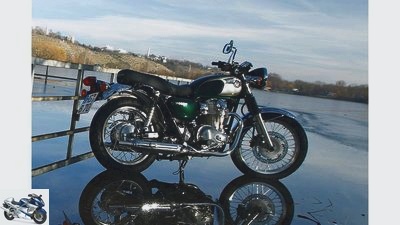
8/16
Kawasaki W 800.
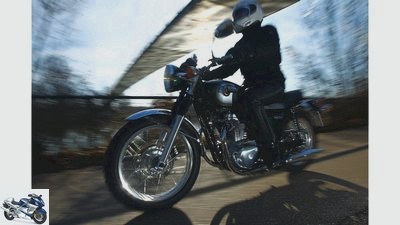
9/16
Kawasaki W 800.
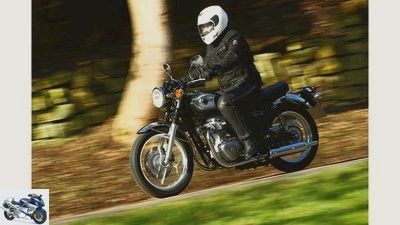
10/16
Kawasaki W 800.
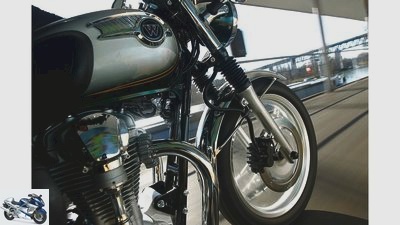
11/16
Kawasaki W 800.
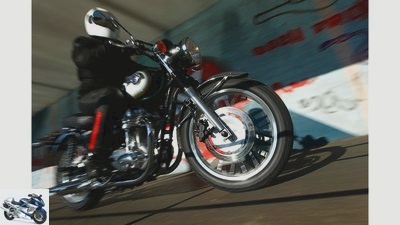
12/16
Kawasaki W 800.
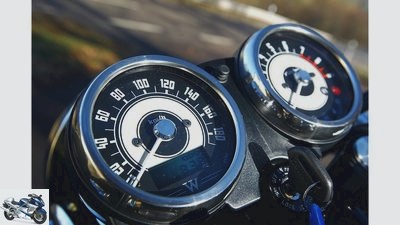
13/16
Kawasaki W 800.
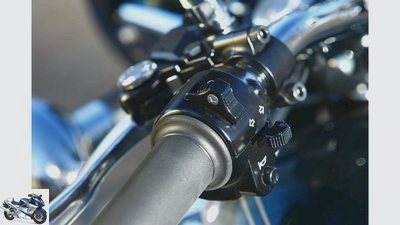
14/16
Kawasaki W 800.
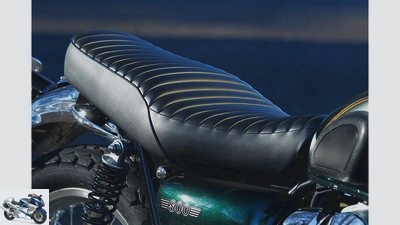
15/16
Kawasaki W 800.
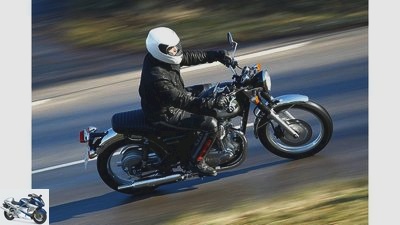
16/16
Kawasaki W 800.
Euro 3 classic: Kawasaki W 800
How was that yesterday?
The Kawasaki W 800’s performance did not stir emotions, but we will miss it and love it for its unique and backward-looking design.
The trendsetter: He sets a fashionable or technical trend, at best even both in motorcycle construction, and becomes the leading model in a sector. The Kawasaki W 800 brought all the systems with it. Only when she was born in 1999, when she was 650, nobody recognized her as a trendsetter. A couple of historically entranced two-wheeler enthusiasts threw their hands over their heads with happiness when they saw the vertical shaft drive for the camshaft actuation on the air-cooled two-cylinder, but the rest of the two-wheeler community put out their feelers for more modern goods. But: “The times they are a-changin ‘”.
In 2011, Kawasaki therefore dared to try the second time. Now the chic co-driver had around 800 cubic centimeters. He had preserved his radiance from the first generation and offered plenty of optical delicacies. Starting with the classic tank emblem, the spoke rims, the quilted seat bench, the curved rear fender or the absolute highlight, the engine. Sit down, pour the good red wine into your glass and let your gaze wander over the Kawasaki W 800 – motorcycle-inspired idleness in perfection.
The performance of the Kawasaki W 800 wasn’t captivating
But at the latest when the rush of red wine was gone, and the sober reality was back, you found many reasons why the W 800 never achieved great success. Motorcycles aren’t just built to look at. They should carry you heartfelt across country roads, enrich your life. With everything that can only be roughly summarized under the term dynamics, neither the Kawasaki W 800 nor the W 650 could ever serve. A full tank of 217 kilograms, plus an engine that tormented its despair through the rev range, mobilized a modest 48 horsepower at 6500 rpm: Your own character had to be very comfortable in order to enjoy it in the long term. There were also heavy vibrations, sluggish brakes and a sound that left every pilot in the dark about whether the engine was really pulsing or was still off.
This performance was not enough because it didn’t tie you up, didn’t capture you, it didn’t arouse emotions. Unfortunately there was only a lot of emptiness and indifference. Even the currently rampant retro trend in the motorcycle industry didn’t change that. And yet we’ll miss the Kawasaki W 800, always loving it for its unique, backward-looking design. Keep them in mind as a courageous but failed trend setter. And who knows, maybe there is still someone out there who has plenty of free space in the living room for a beautiful pedestal including a W 800 – for letting your eyes wander over a good glass of red wine.
Technical data Kawasaki W 800
We’ll miss the Kawasaki W 800, always love it for its unique, backward-facing design.
engine:
- Air-cooled two-cylinder four-stroke in-line engine, a balancer shaft, an overhead camshaft driven by a vertical shaft, four valves per cylinder, rocker arm, wet sump lubrication, injection, 2 x Ø 34 mm, secondary air system, alternator 252 W, battery 12 V / 12 Ah, mechanically operated multi-disc Oil bath clutch, five-speed gearbox, O-ring chain, secondary ratio 2.467.
- Bore x stroke: 77.0 x 83.0 mm
- Displacement: 773 cm³
- Compression ratio: 8.4: 1
- Rated output: 35.0 kW (48 hp) at 6500 rpm
- Max. Torque: 60 Nm at 2500 rpm
landing gear:
- Double loop frame made of steel, telescopic fork, Ø 39 mm, two-arm swing arm made of steel, two spring struts, adjustable spring base, front disc brake, Ø 300 mm, double-piston floating caliper, rear drum brake, Ø 160 mm.
- Spoked wheels with aluminum rims: 2.15 x 19; 2.75 x 18
- Tires: 100/90 19; 130/80 18
Dimensions + weights:
- Wheelbase 1465 mm, steering head angle 63.0 degrees, caster 108 mm, front / rear suspension travel 130/106 mm, seat height * 800 mm, weight with a full tank * 217 kg, load 183 kg, tank capacity 14.0 liters.
- Guarantee: two years
- Service intervals: 6000 km
- Price: 8290 euros
- Additional costs: 170 euros
* MOTORCYCLE measurements
Related articles
-
Comparison test between Kawasaki VN 800 Classic and Suzuki VZ 800 Marauder
Comparison test, Kawasaki VN 800 Classic, Suzuki VZ 800 Marauder Kawasaki VN 800 Classic versus Suzuki VZ 800 Marauder Kawasaki VN 800 and Suzuki VZ 800…
-
Review Kawasaki VN 1500 Classic Tourer
Review Kawasaki VN 1500 Classic Tourer Me, myself and I. Cruising as therapy: Kawasaki makes it possible. The VN 1500 Classic Tourer offers the necessary…
-
Top test: Kawasaki VN 1700 Classic
Top test, Kawasaki VN 1700 Classic Kawasaki VN 1700 Classic The design from a single source, as always. In addition, even more displacement, more punch…
-
Review Kawasaki VN 800 Classic
Test, Kawasaki VN 800 Kawasaki VN 800 Classic If it was a chopper, then a Harley, they thought at Kawasaki. Then the spit stays away for a moment. This…
-
Kawasaki Z 800, Yamaha MT-09 and BMW F 800 R in a comparison test
35 photos 1/35 The center is no longer where it used to be. Because bikes with displacements around 800 cm³…
-
Kawasaki Z 650 in the driving report
Kawasaki 9 photos Kawasaki 1/9 Photo gallery: Kawasaki Z 650 in the driving report. Kawasaki 2/9 The diet worked: Compared to the ER-6n, the Z 650 has…
-
Comparison test Honda CBR 500 R, Kawasaki Ninja 400, KTM RC 390, Yamaha YZF-R3
r-photography.info 29 photos r-photography.info 1/29 Honda CBR 500 R, Kawasaki Ninja 400, KTM RC 390 and Yamaha YZF-R3 in comparison test….
-
On the move: Benelli 750 Sei, Honda CBX 1000, Kawasaki Z 1300
Bilski 17th photos Bilski 1/17 Who is the widest in the whole country? The angle of spread of the driver’s legs provide information. Bilski 2/17 With…
-
Driving report HTMoto-Moto Guzzi V7 Classic Racer
fact Driving report HTMoto-Moto Guzzi V7 Classic Racer Sense and sensuality It invites you to a rollercoaster of emotions, this classic round engine…
-
Cruiser comparison test: Honda VTX 1300 S, Kawasaki VN 1600 Classic
Cruiser comparison test: Honda VTX 1300 S, Kawasaki VN 1600 Classic Damn long hard Handy six-centimeter chunks, wheelbases begging in the parking bay,…